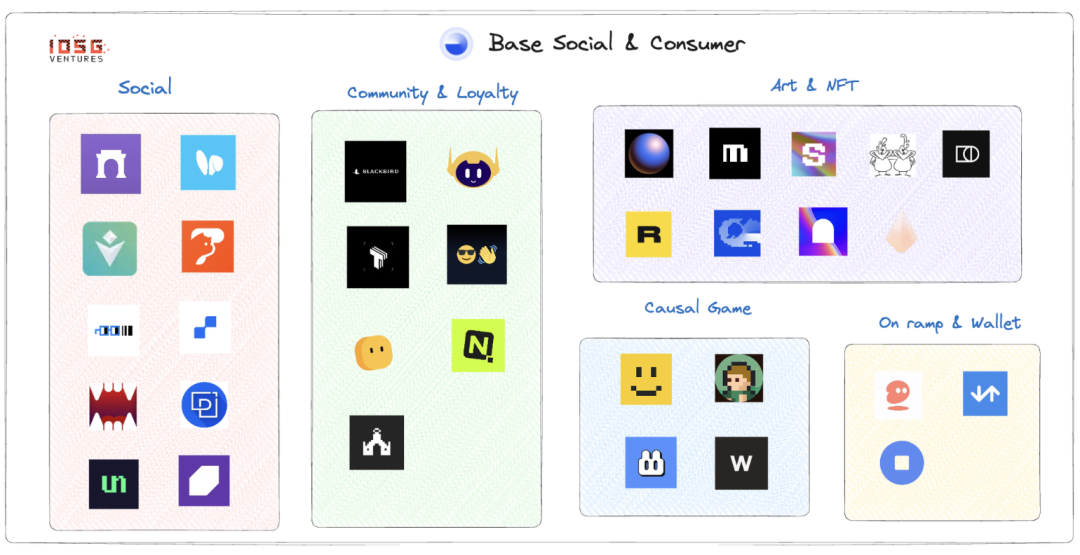
TL, DR:
- Background: Recently, Base has seen significant growth in on-chain data and ecosystem, which we believe is due to various factors: the Cancun upgrade has greatly reduced L2 fees, lowering user interaction costs; backed by Coinbase, the project receives comprehensive support in terms of funds, users, and projects, with active investments from Coinbase Ventures and top-tier funds in the Base ecosystem; a win-win strategy with OP Superchain.
- Base has focused on unique social and consumer applications, aiming to capture user traffic. This article focuses on Base's social and consumer application ecosystem, categorizing some popular projects into social/community, user loyalty management/art and NFT/leisure games, and introduces some of these projects.
- Summary: Base has a low likelihood of issuing coins under compliance and regulatory requirements, yet it has achieved a thriving ecosystem without using token incentives. With a favorable infrastructure, Base's consumer applications and social ecosystem have the potential to onboard more new users and achieve mass adoption.

Background: Cancun Upgrade and EIP4844, Significant Reduction in L2 Fees
With the completion of the Cancun upgrade, L2 has greatly benefited. The most relevant aspect of the Cancun upgrade to L2 is the EIP4844 proposal, which introduces a new data storage structure: Blob, specifically for storing transaction data submitted from L2 to L1. With the introduction of Blob, L2 transaction data is directly submitted to Blob for storage, which can be fully downloaded by consensus nodes and then deleted after a brief delay, reducing unnecessary storage burden. This means that the introduction of Blob will greatly reduce L2 transaction fees. Additionally, Blob effectively expands the block space for L2 and significantly increases L2 transaction throughput. EIP4844 is essentially a transitional upgrade to prepare for the future, aiming to achieve complete Danksharding (the final part of the Ethereum "Tranquility" phase upgrade).
On the Ethereum main chain, data availability is provided through Calldata (data generated in contract transaction calls), and data transmitted from Layer 2 to Layer 1 is stored in Calldata. Additionally, for security, each step of Calldata execution requires Gas, resulting in significant gas costs. However, the transaction data in Calldata has limited utility after verification, and long-term data can be downloaded and verified without needing to be transmitted to the execution layer. Before the Cancun upgrade, for example, nearly 80% of the fees on the OP chain came from L1 data fees. As an example of the cost of interactions on the Base chain, the gas fee for swap decreased from $0.59 to $0.01 after the Cancun upgrade, approximately 1.6% of the previous fee, and the gas fee for sending decreased from $0.178 to $0.003, approximately 2% of the previous fee. EIP4844 has reduced Base's fees to a level comparable to Solana's when the network is relatively idle.
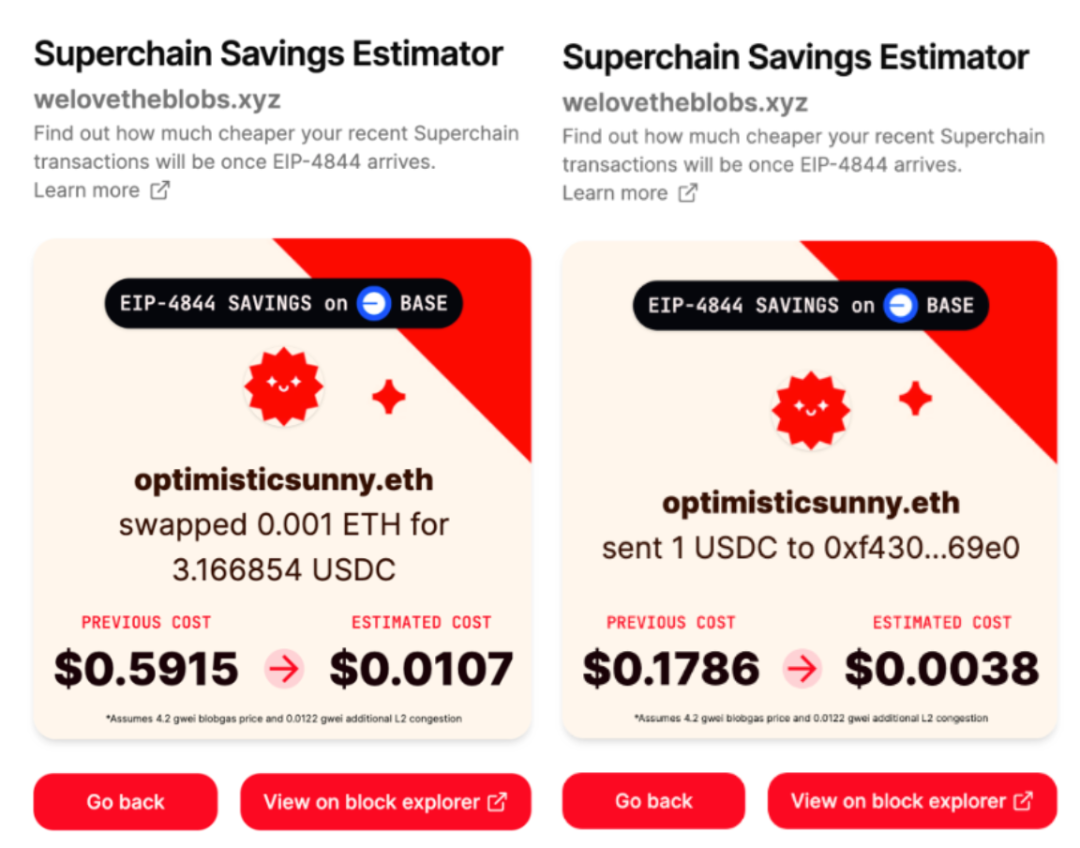 source:welovetheblobs.xyz
source:welovetheblobs.xyz
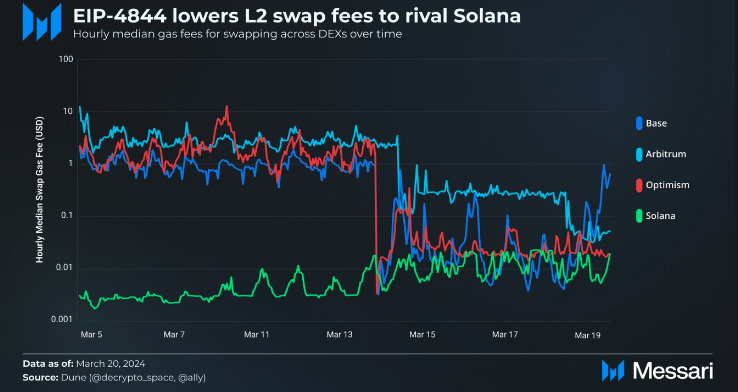
With the significant reduction in L2 gas fees, the Base chain has experienced a substantial increase in TVL and on-chain activities (the green dots in the graph represent the time points of the Base mainnet launch and the start of Blob application). In the past thirty days, there have been over 64 million on-chain interaction records, and the current TVL has exceeded $500 million, reaching a historical high and becoming the second largest L2 after OP and Arbitrum.
 Source:https://l2beat.com/scaling/projects/base
Source:https://l2beat.com/scaling/projects/base

Comprehensive Support from Coinbase
As an L2 built by the Coinbase team, Base has unique advantages backed by the largest publicly traded exchange in the United States. One of the biggest advantages of the Base chain is its large user base and substantial asset accumulation through Coinbase. Therefore, Coinbase only needs to establish a chain to connect the Base chain with the Coinbase exchange and wallet ecosystem. On March 27, Max Branzburg, Vice President of Coinbase, stated on social media, "In the future, Coinbase will store more enterprise and customer USDC balances on Base. This allows Coinbase to manage and protect customer funds at lower costs and faster settlement times without affecting the Coinbase user experience. Coinbase is excited to continue moving business onto the chain and hopes that other companies will follow suit."
Recently, Coinbase Wallet launched the AA Wallet (http://smart-wallet.xyz), eliminating the need for cumbersome operations for ordinary users. Users can directly create accounts using their mobile or computer devices, touch ID, or Google accounts, and can also directly connect to their Coinbase accounts, laying the foundation for attracting a large number of users and funds to the Base chain.
Coinbase Ventures is also very active in investing in the Base ecosystem, with several projects in its portfolio choosing to develop their ecosystems on the Base chain. The Base Foundation is also very active, investing in and incubating dozens of projects in various fields such as social and DeFi. Thanks to Coinbase's industry position and the network effect of Coinbase Ventures, many applications in the Base ecosystem have received primary market attention and favor, with support from well-known capital firms such as Paradigm, a16z, Multicoin, DragonFly, Variant Funds, and 1confirmation.

Superchain Strategy: A Win-Win Collaboration with OP
"Superchain" is an L2 network, and the OP Chain is a single chain within the Superchain. Regardless of its specific attributes, if it is formally managed by the Optimism Collective, it is considered an OP Chain and therefore part of the Superchain, sharing security, communication layer, and open-source technology stack. Unlike a multi-chain design, the OP Chain is standardized and intended to be used as interchangeable resources, allowing developers to build applications targeting the entire Superchain and abstracting the underlying chains for running applications.
Base has reached a win-win strategic cooperation with OP:
Base commits to contribute 2.5% of the total revenue of the Base sequencer to OP, and if it exceeds 2.5%, it will directly contribute 15% of the total profit of Base to OP. In return, OP allows Base to participate in ecosystem development and has the "opportunity" to receive 2.75% of the total supply of OP Tokens.
The Base chain, built on the OP Stack, is currently maintained by Coinbase, and will gradually decentralize in the future. According to DeFiLlama data, the daily revenue of the Base chain is second only to Arbitrum among L2 chains.
 Source: https://dune.com/niftytable/rollup-economics
Source: https://dune.com/niftytable/rollup-economics
In the short term, this cooperation is beneficial for initially upgrading the Optimism mainnet, Base, and other L2s to a Superchain structure with shared bridging and sequencing, and more L2s are expected to be included in the "Superchain" ecosystem in the future. In the long term, the "Superchain" has the potential to develop into a vast network, maximizing interoperability, sharing decentralized protocols, and standardizing its core primitives, facilitating flow and development between chains and ecosystems.

Sustainable Social Universe Led by Farcaster
Farcaster is a decentralized social network protocol designed to establish direct connections between users, allowing developers to access public data without permission, supporting diverse and flexible client and application development, encouraging innovation and experimentation, and providing users with rich social experiences and choices. Farcaster manages user identities on the Ethereum and OP chains but stores messages and posts in the off-chain Hub network to improve speed and reduce costs. As an open social protocol, Farcaster allows various applications to be built on top of it. Currently, Warpcast is the most popular client on Farcaster. Frames, a newly developed feature similar to embedded mini-programs, allows developers to embed interactive experiences in Farcaster posts (casts). These interactive experiences range from voting, minting NFTs, building games, to integrating instant transaction checkout links directly in social media updates, meeting diverse social platform needs.
As an important part of the Base ecosystem, the open protocol of Farcaster has spawned many products, such as the creator platform Paragraph, the content financialization client Jam, the community task platform Bountycaster, and the developer tool Neynar.
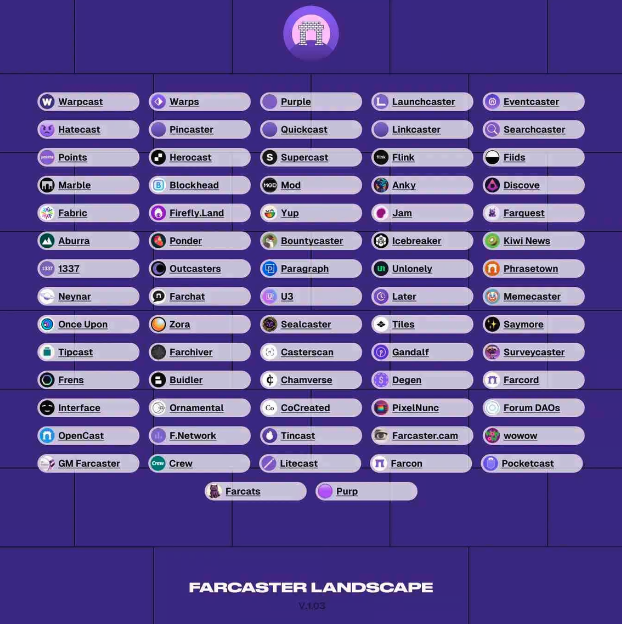 Source: @vahidsuperstar
Source: @vahidsuperstar
In addition to top-down project development, Farcaster also has a strong meme culture and wealth effect, undoubtedly playing a significant role in attracting users and enriching the ecosystem. For example, the leading meme on Base, $Degen, has evolved beyond the realm of basic memes and now plays an important role in the entire Base social ecosystem. $Degen originated on the top-tier social protocol Farcaster and was airdropped to active users in the /degen channel. With the introduction of mini-program functionality and the open registration of the Warpcast client on Farcaster in February this year, there has been a significant increase in users, leading to more attention for $Degen. The initial airdrop distributed 15% of the total supply, and users can still earn rewards by providing liquidity on Uniswap, participating in meme contests on Farcaster, and receiving tips. The team raised 490.5 ETH in the angel round, with individual investors mainly being Ethereum OGs, with 1confirmation leading the investment. The team's website reveals that Degen has also built its own L3, using $Degen as the base token, and the current market value of $Degen is $1.24 billion.
A noteworthy trend is that many emerging projects in the Base ecosystem are using $Degen as the functional token of the project, leveraging the large $Degen holder traffic to achieve the cold start of the project. For example, perl_xyz rewards users with $Degen for playing games, and users can deposit/withdraw $Degen within the app or convert it to $perl. The project also received a 10 million $Degen ecosystem reward. drakulaapp, Web3 Tiktok, or the video version of FriendTech, received a 20 million $Degen incentive to reward creators on the application. The price for each creator is quoted in $Degen. Superfluid_HQ developed a framework called StreamYoink, also using $Degen for payments. BracketHQ is a sports betting game where users can trade tickets for various sports leagues (NFL, NBA, NCAAB, etc.). http://Rounds.wtf, initiated by Nouns, also uses $Degen as the token.
With the development of Base and Farcaster, it is clear that $Degen will gradually become an indispensable part of the social graph. A healthier meme culture atmosphere also contributes to the long-term benign development of the ecosystem.

Other Social Products: Various Innovative Attempts
In addition to Farcaster, there are many innovative attempts and developments of social products on Base, such as the popular Friend.Tech, which has generated nearly $30 million in fees in the past six months and currently has a TVL of nearly $40 million. Friend.tech is a decentralized social application based on the Base chain, combining fan economy and on-chain gaming. Users enter specific rooms to view content by purchasing the token "KEY," and an increase in the number of purchases raises the price of key, with the average fees collected during the buying and selling process being distributed to the platform and room owners.
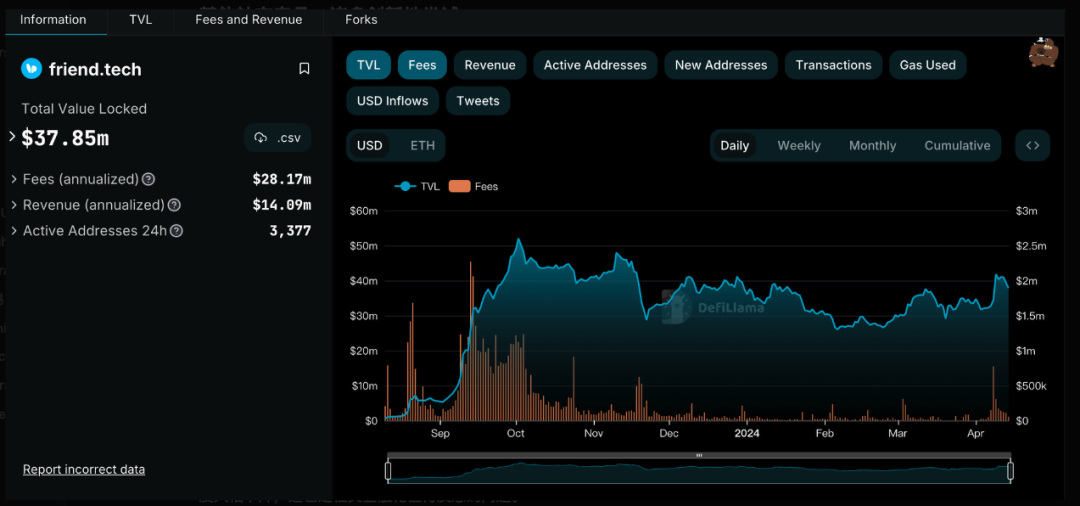
Due to high transaction fees, a strong speculative atmosphere, and a less smooth user experience, the trading activity of FriendTech has significantly decreased for a period, which is also a problem worth reflecting on in the social financialization.
The recently popular projects include Sofi, Web3 Tiktok, Drakula, and the live streaming platform Unlonely. Drakula is a Web3 short video publishing platform where users can upload and publish their own videos or watch others' videos. The platform's points, Drip, can be obtained by making videos, sharing referral links, completing platform tasks, or buying tokens from other creators, and can also be used to reward other creators. Similar to FriendTech, creators on the platform have their own tokens, priced in Degen, and the higher the popularity of the creator, the higher the unit price of the token, allowing users to view the most popular creators on the platform (higher token price, more rewards received).
Unlonely is a Web3 live streaming platform where users can choose to create their own live channels or watch others' live streams. The platform's token is $VIBES, and users can purchase vibes for tipping. Users can view the upcoming event calendar on Unlonely, search for resident anchors, and watch live stream replays.
Community Management and User Loyalty
Projects related to community management and user loyalty have emerged and developed alongside social projects, such as the $24 million-funded loyalty and membership platform Blackbird, which aims to establish deeper connections between restaurants and their most loyal customers. Blackbird allows customers to create NFT memberships for the restaurants they frequent. These NFTs can unlock various rewards, such as earning $FLY tokens, SMS concierge services, and "kitchen surprises" during dining. This approach provides diners with new levels of engagement and value. Blackbird is decentralizing restaurant loyalty programs, allowing users to earn points not limited to a single system; then, users can flexibly trade $FLY tokens and accumulated NFTs on the chain. This system provides customers with a more flexible and valuable form of rewards, representing a shift in traditional loyalty programs.
Projects like QuestN provide assistance for project advertising and promotion. Project teams can use QuestN to publish tasks and tests for better promotion, deepen user understanding of the product, and provide a basis for user rewards. PartyDAO is a community crowdfunding platform where users can propose projects, crowdfund, and discuss with interested builders in the chat room to drive project development.
NFT and Art
As Jesse, the head of Base, said, "Onchain is the next online," Base is committed to bringing art and creative content onto the chain. Zora is also an NFT creation and distribution platform that provides various tools for creators and has built its own chain. Thanks to the active Base ecosystem, Zora's TVL has shown significant growth. Creators can also choose to release their projects on NFT minting platforms like Manifold and Rarible. The number of NFT transactions on Base has also shown significant growth in the past two months, with average daily transaction volumes ranging from hundreds of thousands to millions of dollars, and nearly ten thousand daily transaction addresses.
Casual Games
Unlike other public chains that pursue AAA/high TPS games, Base seems to be more interested in casual mobile games. For example, Frenpet is an electronic pet casual game where players can earn points by feeding pets and battling other players' pets. The higher the points, the higher the ranking on the leaderboard and the ETH rewards. Fren Pet uses an invitation system for social propagation, where referrers can receive 10% of all FP spent by invitees within the app, achieving new user acquisition and activation at zero cost, earning it the title of "FriendTech version of blockchain games." There is a 4% fee when trading FP tokens, with 2% rewarded to players, 1% to the team, and 1% to LP. Currently, there are around 8,000 cumulative users, and the market value of the Fren Pet token is $70 million.
The Telegram sticker financialization platform Sofamon is currently creating a personal chat sticker market on Telegram, where users can manage their sticker collections, invite friends, and access Sofamon's private chat rooms. Similar to Friend.Tech, each sticker accessory has a price curve, with early buyers getting a lower price and later buyers pushing the price higher for profit. Shortly after its launch, Sofamon's transaction volume has approached 7,000 ETH, with protocol revenue close to 300 ETH.
On-Ramp and Wallets
Most consumer applications or social projects also focus on improving user registration and usage thresholds, enhancing the user experience to some extent. The $18 million-funded wallet solution Privy aims to solve the contradiction between the poor user experience of multiple wallets and the privacy risk leakage of integrated login through Web3 solutions. Users can log in to Web3 applications through traditional accounts such as Google and Apple ID and automatically generate encrypted wallet addresses, greatly reducing the user's usage threshold.
Meme
Memes have become an indispensable part of social and consumer applications. The current status of meme coins is highly controversial because their culture is a mechanism that promotes (similar to) gambling. However, mimicking online behavior is a very popular entertainment tool on the internet. Airdrops in the Farcaster channel have given birth to meme coins with market values exceeding tens of millions of dollars, and the spread and development of these meme coins have in turn benefited the entire social ecosystem, making users more active. It can be concluded that memes have become an important means for community and project launches.
As Blockchain Capital analyst KINJAL SHAH said, "Although it is still in its early stages and has not yet taken its final form, a toolkit for web3 creators is gradually emerging. Mechanisms such as points and airdrops reward the use of protocols. In terms of airdrop design, there is still a lot of room for improvement towards maturity, such as restrictions on whitelists and release mechanisms, all of which have the potential to give rise to more specific reward mechanisms. Further growth is being driven through existing communities, on-chain referral rewards, and 'token social proof'." Pantera partner Paul Veradittakit also expressed his love and optimism for meme coins: "I am very clear that meme coins will not disappear. I see the next generation viewing meme coins as a very interesting social activity. Although meme coins may look like toys, they are the Trojan horse of cryptocurrency. They are the easiest way for the next generation to experience the latest DeFi applications and introduce them to Web3."
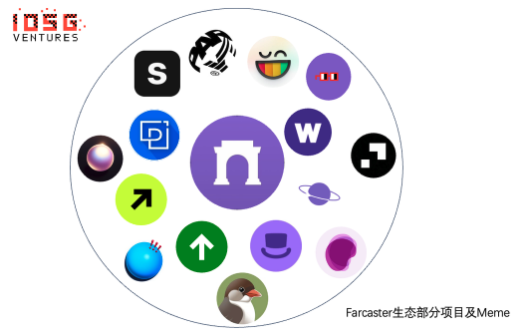

Conclusion
Social and consumer applications are undoubtedly the most promising direction for achieving large-scale blockchain applications. From the current development, we believe that the Base ecosystem is in a leading position. The Cancun upgrade has greatly reduced L2 fees, almost eliminating gas friction, significantly reducing user interaction costs, which can better meet the high-interaction, low-gas infrastructure needs of consumer applications. Multiple applications have already achieved high income relying solely on transaction fees. Base, as an L2, has unique advantages and community taste, giving it the potential to attract a massive number of new users and achieve large-scale adoption. More and more users are expected to join the Base ecosystem, achieving the goal of Mass Adoption.
Reference:
https://dune.com/cs-research/base-mainnet-bridge-activity
https://foresightnews.pro/article/detail/56194
https://www.theblockbeats.info/news/49785
https://unchainedcrypto.com/3-reasons-why-layer-2-network-base-has-more-than-doubled-its-total-value-locked-this-year/
https://www.chaincatcher.com/article/2088168
免责声明:本文章仅代表作者个人观点,不代表本平台的立场和观点。本文章仅供信息分享,不构成对任何人的任何投资建议。用户与作者之间的任何争议,与本平台无关。如网页中刊载的文章或图片涉及侵权,请提供相关的权利证明和身份证明发送邮件到support@aicoin.com,本平台相关工作人员将会进行核查。




